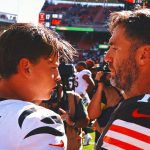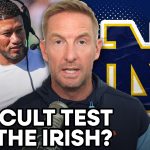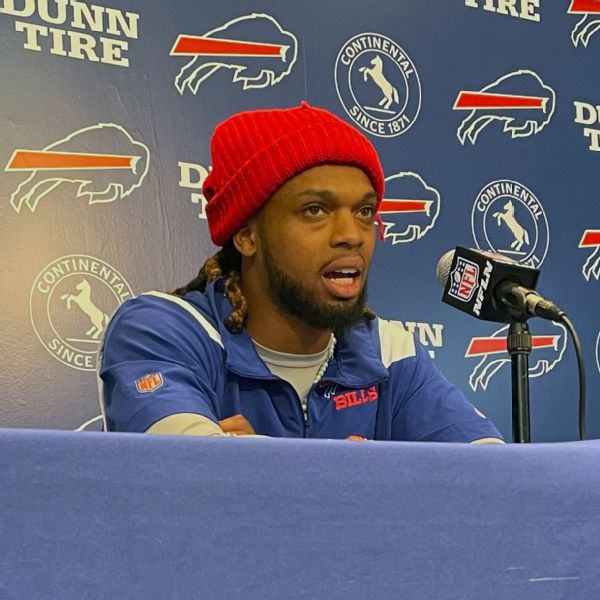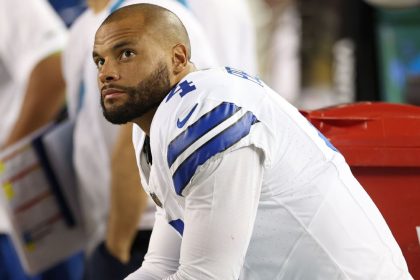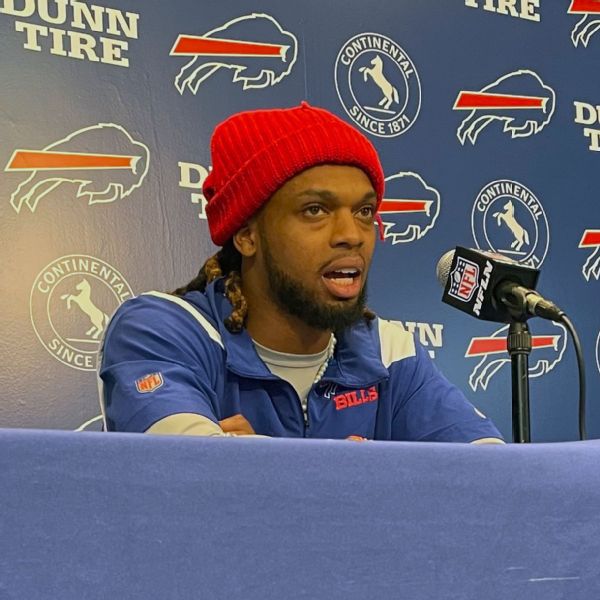
ORCHARD PARK, N.Y. — Just over 3½ months after commotio cordis caused Damar Hamlin to collapse on a football field in Cincinnati, Hamlin sat in the Buffalo Bills‘ facility and officially announced his plans on making a comeback to the NFL after being fully cleared to return to playing football.
But the remarkable achievement of going from suffering cardiac arrest on national TV to returning to workouts with his teammates is just the next chapter in Hamlin’s journey.
“This event was life changing, but it’s not the end of my story,” Hamlin said.
Hamlin shared Tuesday — during his first news conference since the events on Jan. 2 during the first quarter of a regular-season “Monday Night Football” game against the Cincinnati Bengals — that doctors concluded that Hamlin suffered a specific type of cardiac arrest, commotio cordis, “an extremely rare consequence of blunt force trauma to the heart that happens at exactly the wrong time in the heart rhythm, causing the heart to stop beating effectively,” per the American Heart Association. Collapsing occurs within a few seconds.
For the 25-year-old safety, who has been cleared by multiple specialists, returning to the field is something that he wants to do for himself.
“My heart is still in the game. I love the game. It is something I want to prove to myself, not nobody else,” Hamlin said. “I just wanna show people that that fear is a choice that you can keep going in something without having the answers and without knowing what’s at the end of the tunnel. Or you might feel anxious, you might feel any type of way, but you just keep putting that right foot in front of the left one, and you keep going. I want to stand for that.”
Commotio cordis is a “diagnosis of exclusion,” Dr. William Knight IV, professor in the Department of Emergency Medicine at the University of Cincinnati College of Medicine, Director of the Emergency Medicine MLP Program and part of Hamlin’s care team, said in January. That means that more common, deadly or fixable conditions have to first be ruled out before commotio cordis is the diagnosis.
There are no risk factors for commotio cordis, per the American Heart Association, which also cites out-of-hospital sudden cardiac arrest as the leading cause of death for student athletes. Lowering numbers like that, Hamlin said, is something he “personally will be taking a step in to make a change.”
Hamlin saw his last of three heart specialists, who were located in various parts of the country, Friday and is in attendance and participating at voluntary workouts with the Bills this week. Bills head athletic trainer Nate Breske also accompanied Hamlin on those trips.
That final specialist went so far as to tell Hamlin that he felt returning to playing would be good for his mental health.
“Being around my teammates, the camaraderie of the sport of football, you know, that’s what makes this sport the best in the world, is the brotherhood that it creates, the unity that it creates between all people of all aspects of life and just different journeys, it brings them together for one common goal,” Hamlin said. “And I feel like that’s a direct correlation of what happened to me that night, you know, just bringing people together in prayer, love, but that’s what this sport does as well, so my heart is in it completely and it takes a lot to be great in this game, and I got a long way to go. I got a long journey to go, but I’m committed to it each day, day in, day out.”
The steps ahead for Hamlin includes taking things one day at a time and the mental steps of gradually upgrading to playing football. The mental journey and rollercoaster of emotions is the “hardest hurdle,” per Hamlin, but he noted how he has the right people in his corner, including those in the Bills’ facility.
Bills general manager Brandon Beane said that all of the specialists were in agreement on Hamlin’s case and on his being able to fully return to playing football.
“When he left Cincinnati, he came here, it was Buffalo General [Medical Center],” Beane said. “He saw a couple of specialists here in Buffalo, and then, since then, he’s seen three additional specialists, most recently on Friday, and they’re all in agreement. It’s not 2-1 or 3-1 or anything like that. They’re all in lockstep of what this was and that he’s cleared, resumed full activities just like anyone else who was coming back from an injury or whatever.”
The Bills began their voluntary offseason program Monday. The team shared a video of the team’s workouts which included Hamlin going through a variety of exercises alongside his defensive teammates.
Bills coach Sean McDermott and Beane emphasized that the team will continue to support Hamlin from a mental health perspective.
“He’s moving forward one step at a time here,” McDermott said. “He’s been cleared from a physical standpoint, and we’ll provide all the mental help we can from a mind, body and spirit standpoint.”
Last month, Hamlin spent time in Washington, D.C., to help promote the bipartisan legislation Access to AEDs, which would increase the availability of automated external defibrillators — and related training — on school campuses. He also met with President Joe Biden at the White House.
The NFL has launched the Smart Heart Sports Coalition, a collaboration with several groups to advocate for policies in all 50 states aimed at preventing fatal outcomes from sudden cardiac arrest among high school athletes. The goal of the coalition is to pass legislation at the state level and implement these policies within the next three years, and the group sent letters to governors of 43 states where it believes additional policies are needed.
Hamlin has had a busy couple of months, including receiving the NFLPA’s highest honor, the Alan Page Community Award, for his work helping others. His Chasing M’s Foundation raised more than $9 million in the days after he went to the hospital, with the money largely going through GoFundMe for a toy drive that had an initial goal of $2,500. Giving back to the youth is a priority for Hamlin, who noted how he has been beating statistics his whole life coming from McKees Rocks, Pennsylvania, playing and graduating from Pitt and building a career in the NFL, while helping his community along the way.
Despite all that has come, Hamlin said “wow” moments for him are being able to wake up every day and be around his family, “the biggest blessing of it all is for me to still have my people and my people still to have me.”
“It’s just good when great things happen to great people,” Bills pass-rusher Von Miller said. “With everything that has happened, he’s took full advantage of it, and he’s used the platform that he’s had from the exposure from everything that has happened, and he’s used that for good. And not just one time but multiple times. He’s been to the White House. He’s talking to kids like, he has taken full advantage of the opportunity that God has given him, and to see him get cleared to play football again, because I know all of that stuff, even though it’s great, but it really comes, for him, and I’m just speaking for him, it really comes secondary on going out there and living out your childhood dream.”
Hamlin was also recognized alongside the medical and athletic training staff of the Bills and Bengals and some of the staff from the University of Cincinnati Medical Center at the NFL Honors and on the field before Super Bowl LVII.
“It’s exciting to go from a guy who was fighting for his life to who is now, his story hasn’t been written,” said Beane, who spent multiple days in the hospital with Hamlin and his family. “Now it’s about the comeback, and so, to see that he, it was all about his health and it’s still, it’s always going to be about his health, but to truly, however many months later, be talking about he’s been fully cleared is pretty remarkable. And I’m excited for him and his family at where they are in this journey.”


